
Astruc D. - Modern arene chemistry (2002)(en)
.pdf
5.2 The Aromatization of Hexa-1,3-dien-5-yne to Benzene: Mechanism and Preparative Applications 173
Scheme 5. A new route to condensed aromatic hydrocarbons.
Scheme 6. The dimerization of an isobenzene intermediate.

174 5 From Acetylenes to Aromatics: Novel Routes -- Novel Products
As in the case of the parent molecule 6, 17 can subsequently stabilize itself to 18 by hydrogen migration or, as a highly reactive cycloallene, participate in a [2þ2]cycloaddition. This process, which can only be observed at lower isomerization temperatures, leads to the bis(methylene)cyclobutane intermediate 19 [13]. Cleavage of its weakest bonds (see wavy lines) could subsequently generate a resonance stabilized diradical, which, by reformation of a carbon–carbon single bond, would furnish 20, with the generation of two fluorene moieties and a bis(methylene)cyclobutene core providing the driving force. Whether a reversal of these steps takes place at higher temperatures or the intermediate 20 finds an alternative route to the final product 18 is an open question at present. The yields have been satisfactory in all cases studied so far, and the substitution pattern can presumably be varied over a considerable range. The starting acetylenes are easily available in good yield [11, 12] by Wittig or Peterson olefination of the appropriate mono and diacetylenic aldehydes and ketones.
So far, only the cycloaromatization of precursors possessing an acyclic hexadienyne unit has been discussed. That this route probably also has considerable potential as a cyclic variant has been shown by the thermal ring-closure of the cyclic dienynes 21 and 24 (Scheme 7).
Hydrocarbon 21, a highly reactive cyclic acetylene has only been generated in situ and rearranges immediately to 23, presumably via the bicyclic isobenzene 22 [14]. The ‘‘tetramethylene-bridged’’ cis-hexadienyne 24 can be characterized, but cyclizes to tetralin (26) even at room temperature [15]. When the length of the oligomethylene bridge is extended, the thermal stability of the starting acetylene is strongly increased [15].
Scheme 7. Thermal cyclization of cyclic hexa-1,3-dien-5-ynes.
The most thorough analysis of the relative contributions of the three competing pathways (see Scheme 3) is due to Zimmermann and co-workers, who have addressed this problem by studying the thermocyclization of various substituted and D-labeled dienynes, in which, inter alia, one of the double bonds was part of a benzene ring. As summarized in Scheme 8 for the two acetylenes 27 and 30, which cycloaromatize to naphthalene (31) and its two monodeuterio derivatives 28 and 29 on flash vacuum pyrolysis, the radical route (pathway (c)) plays a significant role in the formation of all these aromatization products [9, 16].
The carbene insertion route (pathway (b)) has most frequently been implied to explain the thermal cyclizations of various ethynyl-substituted aromatic precursors. Although the other two alternatives cannot be excluded at present, since in many cases (see below) no careful mechanistic studies have been undertaken, the carbene hypothesis has the advantage of
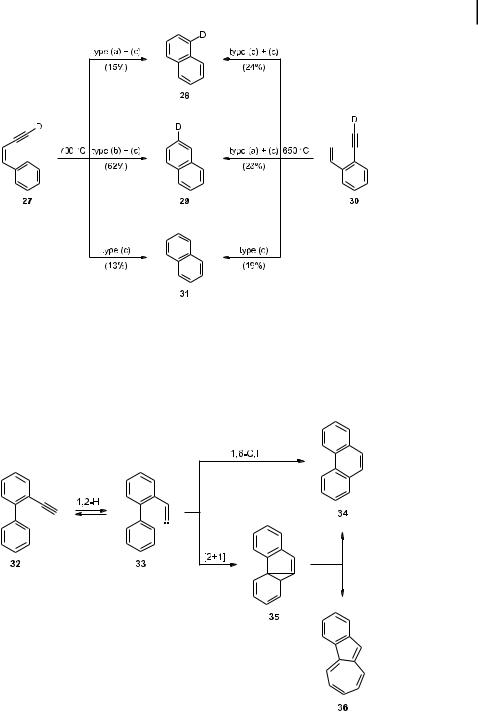
5.2 The Aromatization of Hexa-1,3-dien-5-yne to Benzene: Mechanism and Preparative Applications 175
Scheme 8. Three di erent routes from 1-phenyl-buten-3-yne to biphenyl.
greater simplicity and hence will also be employed here. The prototypical experiment here is Brown’s famous cyclization of 2-ethynylbiphenyl (32) to yield a mixture of phenanthrene (34) and 1,2-benzazulene (36; total yield 99 % at 700 C, 0.2 Torr; product ratio 2.6:1) [17] (Scheme 9):
Scheme 9. The thermal cyclization of 2-ethynylbiphenyl (32) to phenanthrene (34) and 1,2-benzazulene (36).

176 5 From Acetylenes to Aromatics: Novel Routes -- Novel Products
The initially generated vinylidene carbene intermediate 33 has two options for further reaction: it can either undergo 1,6-carbon hydrogen insertion to give 34 or participate in a carbene addition to the phenyl substituent. The latter process leads to the formation of the highly strained norcaradiene derivative 35, which is ring-opened to give 36 under the reaction conditions. If this process occurred in a stepwise manner, the intermediately produced diradical could also participate in a hydrogen-shift process, opening up a second pathway to phenanthrene (34).
The importance of this cycloaromatization in modern aromatic chemistry only became obvious when it was realized that it constitutes an optimal route to bowl-shaped aromatics and fullerene partial structures [9, 18, 19]. The key experiment, Scott’s synthesis of corannulene (40) from 7,10-diethynylfluoranthene (37) [20], was quickly adapted to more extended systems, the examples 38 ! 41 [21] and 39 ! 42 [22] in Scheme 10 being just two of many:
Scheme 10. Bowl-shaped aromatics by high temperature pyrolysis of acetylenes.
In many of these applications, the ethynyl group is present in the starting material only in latent form, e.g. as a chlorovinyl substituent, from which it is liberated during the pyrolysis step. That even non-terminal acetylenes can be employed in these cycloaromatizations is illustrated by the protected cross-conjugated diacetylene 43 in Scheme 11. When this was subjected to hydropyrolysis at 900 C, the diacetylene 44 was generated in situ and doublecyclized to corannulene (40) immediately [23].

5.3 The Construction of Extended Aromatic Systems from Ethynyl Benzene Derivatives 177
Scheme 11. Corannulene (40) from a cross-conjugated enediyne precursor.
5.3
The Construction of Extended Aromatic Systems from Ethynyl Benzene Derivatives
In the examples described so far, the acetylene unit ended up as an integral part of an aromatic system. There is, however, a vast and structurally very varied area of modern aromatic chemistry in which acetylenes that already contain an aromatic system – very often a benzene ring – are used to construct extended aromatic hydrocarbons of sometimes very large dimensions and high structural complexity. In these cases, the acetylene unit(s) is (are) used for connectivity purposes only, and it (they) remain(s) intact and recognizable in the product. Over the years, numerous coupling protocols to achieve these synthetic ends have been developed. At least one of these is as old as Berthelot’s work on the thermal trimerization of acetylene (1) to benzene (2), namely the oxidative dimerization of terminal acetylenes discovered by Glaser in 1869 [24]. Over the years, acetylene coupling reactions have not only steadily been improved (inter alia Eglinton [25] and Hay variations [26] of the Glaser coupling, Cadiot–Chodikiewicz coupling [27], Stephens–Castro coupling [28]), but the arrival of the Heck [29], the Sonogashira [30, 31], and many other metal-mediated coupling reactions [31] have made it possible to construct practically any desired acetylene-containing aromatic framework, whether the coupling reactions are carried out in a symmetrical or unsymmetrical fashion. Acetylenic coupling reactions are the current methods of choice for the preparation of novel oligomers of ethynylbenzene, of dehydroannulene systems, and of new cyclic and polycyclic hydrocarbons containing aromatic rings and triple bonds simultaneously. These compounds are of interest for the study of aromaticity problems, as model compounds for molecular electronics, as subunits of novel allotropes of carbon, and as guest molecules with large cavities. Rather than attempting to cover the vast literature, the discussion here will concentrate on the fundamental aspects of this building block approach to new aromatic hydrocarbons, present a selection of important building units, and show how they are coupled to form greater aggregates. Some of the frequently used building blocks are depicted in Scheme 12.
Beginning with diethynylbenzene derivatives, it is obvious that the para-isomer 45 could lead to rod-like hydrocarbons, whereas the meta- (46) and the ortho-isomers (47), respectively, could provide angular and circular structures. Of course, an increase in the number of ethynyl groups results in an increased number of coupling possibilities. 1,3,5- Triethynylbenzene (48), for example, is of interest since it can be used for the construction of bicyclic hydrocarbons – it constitutes a ‘‘blown-up’’ version of a bridgehead. Clearly, hexaethynylbenzene (49) [32] can function as a ‘‘tile’’ for the preparation of novel forms of
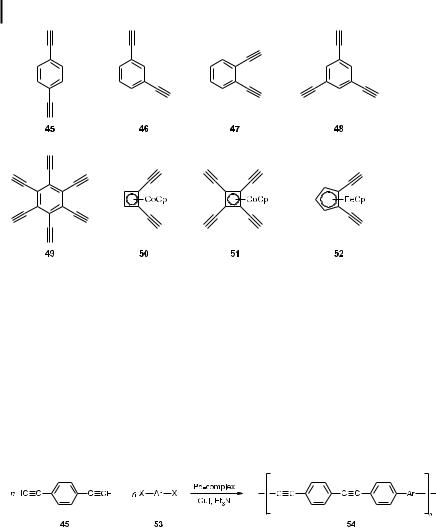
178 5 From Acetylenes to Aromatics: Novel Routes -- Novel Products
Scheme 12. A selection of building blocks for the preparation of large aromatic systems containing triple bonds.
graphite, and the three transition metal complexes 50–52 are shown here not only because they will be used for the building purposes described below, but also since they illustrate that the aromatic core unit may be replaced by metal complexes of anti-aromatic and nonbenzenoid aromatic systems. Furthermore, if one bears in mind that the role of the center unit can also be played by a heteroaromatic system, the structural variability becomes almost endless.
Rod-shaped systems such as 54, extended versions of the widely studied poly(phenylene)s, are available by coupling the para-isomer 45 with a para-dihaloaromatic unit in the presence of a palladium catalyst [33] (Scheme 13):
Scheme 13. The synthesis of rod-like oligomers and polymers of 1,4-diethynylbenzene (45).
Another coupling strategy, often used in this area of aromatic chemistry, has been widely applied by Moore and co-workers for the preparation of shape-persistent molecular architectures of nanoscale dimensions [34]. Thus, as illustrated in Scheme 14, coupling of the Merrifield resin 55 with the diazonium salt 56 provided the triazene 57, with the tert-butyl groups serving as solubilizing substituents in the higher oligomers. The ethynyl group was then introduced by Pd-catalyzed reaction of 57 with trimethylsilylethyne, and the resulting 58 could either be desilylated to give (the still resin-bound) 59 or treated with methyl iodide to give the bisfunctional coupling component 60. In this latter step, the triazene group functions as a diazonium equivalent.
The two units 59 and 60 could then be coupled to give 61 and, by repetition of this sequence, oligomers such as 62 were obtained, which, in the terminating step to yield 63, were

5.3 The Construction of Extended Aromatic Systems from Ethynyl Benzene Derivatives 179
Scheme 14. The synthesis of 1,3-diethynylbenzene (46) derived hydrocarbons: open oligomers.
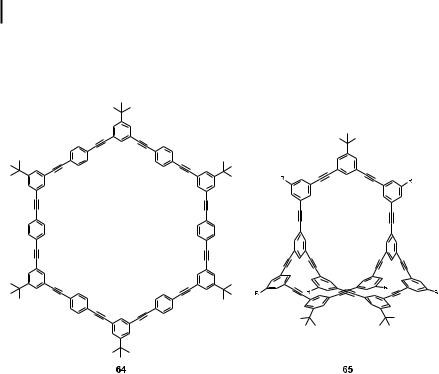
1805 From Acetylenes to Aromatics: Novel Routes -- Novel Products
removed from the solid support by methyl iodide treatment. Using this methodology, not only could discrete oligomers with up to 32 monomer units be obtained, but also cyclic systems such as 64 and the bicyclic derivative 65, the latter illustrating the aforementioned use of 48 as an enlarged bridgehead (Scheme 15).
Scheme 15. Cyclic oligomers based on 46.
The ortho-diethynylbenzene motif 47 can be recognized in countless novel aromatic hydrocarbons, whether these are acyclic or cyclic.
A prototypical acyclic oligomer of 47 is the oligo[1,2-phenylene(2,1-ethynediyl)] derivative 71 prepared by Grubbs and co-workers [35] by the sequence described in Scheme 16. Heck-type coupling of 2-ethynyltolane (66) – itself readily available by Heck reaction from ortho-dibromobenzene – with ortho-diiodobenzene (67) initially provided the orthodiethynylbenzene derivative 68. This was ethynylated to give the terminal acetylene 69, which, on coupling with 67 and another ethynylation/deprotection step, furnished 70. To obtain the phenylacetylene octamer 71 from 70, this latter building block was finally coupled with the diiodide 67.
Interest in preparing cyclic oligomers of 47 has been high not only because these dehydrobenzoannulenes are important model compounds for the study of aromaticity phenomena, but also because they can be regarded as subsystems of two planar carbon allotropes: graphyne (72) and graphdiyne (73). As can be recognized in Scheme 17, these two carbon sheets can be deconstructed in countless ways to give various subsystems: hexaethynylbenzene (49) [32] and hexa(butadiynyl)benzene [36, 37], ortho-diethynylbenzene (47), tetraethynylbenzene, etc.
Whether 72 and 73 can be prepared in a stepwise (‘‘rational’’) synthesis is extremely unlikely, but the preparation of ‘‘highly evolved’’ subunits is a goal that has been realized by several groups in recent years.
Subjecting 47 and some of its derivatives to copper-mediated oligomerization leads to the
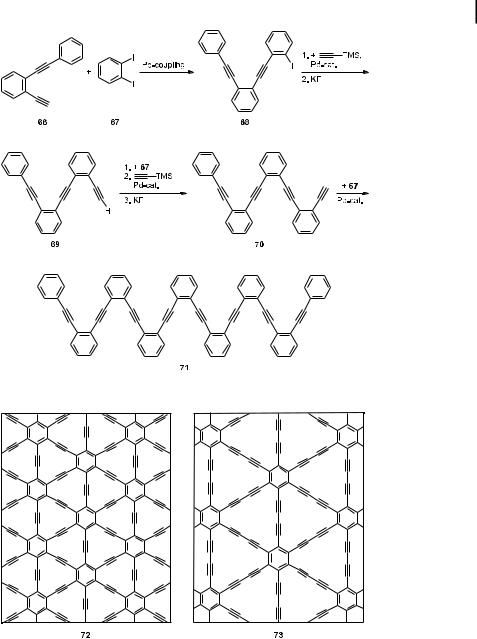
5.3 The Construction of Extended Aromatic Systems from Ethynyl Benzene Derivatives 181
Scheme 16. The synthesis of acyclic oligomers of 1,2-diethynylbenzene (47).
Scheme 17. Graphyne (72) and graphdiyne (73): novel allotropes of carbon.
results shown in Scheme 18. Whereas in the case of the parent system 47 only the dimer 75 is produced [38], the derivatives 74 with R ¼ butyl or O-decyl also give rise to trimer (76) and tetramer (77) formation [39]. Whereas the trimers 76 represent a substructure of graphdiyne, the tetramers 77 possess an unusual box-like structure.
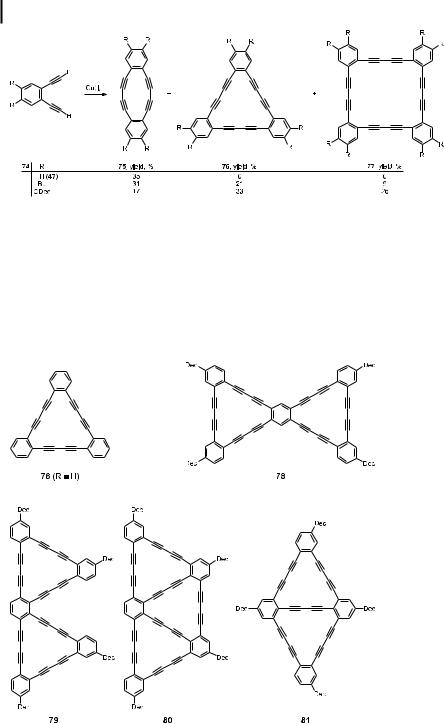
182 5 From Acetylenes to Aromatics: Novel Routes -- Novel Products
Scheme 18. Cyclooligomerization of 1,2-diethynylbenzene (47) and some of its derivatives.
Haley and co-workers in particular have been successful in preparing graphyne and graphdiyne substructures and have synthesized numerous hydrocarbons such as 76 and 78– 81 during the last few years (Scheme 19) [40, 41].
To demonstrate their approach, the preparation of the parent system 76 and the so-called bow-type hydrocarbon 78 is discussed here [42]. To prepare the trimer of 47 (which was not among the oxidative dimerization products, see above), the triyne 82 was coupled with ortho-
Scheme 19. A selection of graphdiyne substructures.
